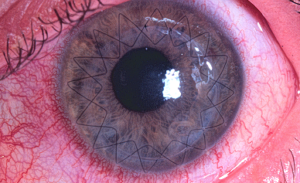Endothelial Keratoplasty
Endothelial keratoplasty
An endothelial keratoplasty procedure (EK, DSEK, DSAEK, or DMEK) is done when the corneal endothelium is not working properly and the cornea is swollen.
The endothelium is a single layer of cells on the back of the cornea (the clear window on the front of the eye). These cells pump fluid out of the cornea all the time to keep it transparent. When they do not work well the cornea swells up and becomes cloudy and that affects vision. In mild cases vision will often fluctuate during a day, typically worse after waking and then clearing somewhat during the day. In worse cases vision is cloudy all of the time. Endothelial cells do not regenerate if diseased or damaged and must be replaced by a corneal transplant procedure. There is no eyedrop or drug therapy presently available that will help the affected layer of cells.
There are 2 common conditions in which the endothelium does not work properly:
Fuchs’ corneal endothelial dystrophy is a genetically-determined condition in which the endothelium gradually fails as people age. Typically, this starts to cause trouble in 50’s but can be a problem earlier than this. Early symptoms include variable blurring of vision in poor light. In addition to the gradual swelling of the cornea causing cloudiness, the membrane (Descemet’s membrane) that attaches the endothelial cells to the back of the cornea gradually thickens and directly affects quality of vision.
The other situation is where the endothelium has been damaged by surgery or trauma or disease. The most common cause of this is after cataract surgery and can occur immediately after or years down the track. This is called pseudophakic corneal oedema.
There are many other less common conditions where the corneal endothelium is damaged or dysfunctional for which endothelial keratoplasty is the only means to improve vision.
Corneal transplantation for endothelial failure
Corneal transplantation for endothelial failure, which causes swelling of the cornea, has traditionally been done as a full-thickness graft (penetrating keratoplasty). This replaces the abnormal or deficient posterior endothelial layer of the cornea but in the process replaces all of the front layers of the cornea as well. The front part of the cornea may not be affected significantly other than being swollen and does not necessarily need to be replaced.
Endothelial keratoplasty has replaced full-thickness transplantation as the procedure of choice for endothelial failure. This procedure involves stripping the diseased back layer from the recipient cornea and inserting just a thin layer of donor cornea with healthy endothelium into the eye. A bubble of air is placed into the front chamber of the eye to force the donor layer on to the back of the cornea and it will stick there by itself. The healthy endothelium will then start working to pump the swollen cornea clear again.
Endothelial keratoplasty has a number of potential advantages over full-thickness transplants. Healing is much faster and the problem of high degrees of astigmatism and defocus that occurs with full-thickness grafts is avoided. There is also less disturbance to the surface of the eye and fewer dry eye problems and there may be a lower chance of rejection.
Types of endothelial keratoplasty
The endothelium can be replaced by a number of surgical techniques:
Penetrating keratoplasty (PK, full-thickness corneal transplant) was the only way of doing this in the past. This involves replacing the whole thickness of the cornea with a circle of donor cornea that is sewn into place with nylon stitches. This is still done in cases where there is scarring of the cornea as well as endothelial problems or if there are adhesions within the front of the eye that make DSAEK or DMEK technically difficult.

Penetrating Keratoplasty
DSAEK or DSEK (Descemet’s Stripping Automated Endothelial Keratoplasty) involves removing the affected Descemet’s membrane and endothelium from the back of the cornea and inserting a thin layer from the back of a donor cornea that carries the new Descemet’s membrane and endothelium.
DMEK (Descemet’s Membrane Endothelial Keratoplasty) is a similar procedure in which only Descemet’s membrane itself and endothelium are inserted into the eye.

